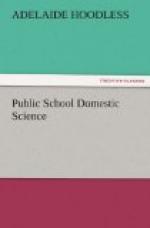OATMEAL.
Oatmeal is one of the most valuable foods. Oats contain fat, proteid, salts and cellulose, in addition to a large percentage of starch. The nutritive value of oatmeal is great, but much depends upon the manner of cooking. (See recipes.) People who eat much oatmeal should lead a vigorous outdoor life. The following analysis of oatmeal is given (Letheby):—
Nitrogenous matter 12.6 per
cent.
Carbohydrates, starch, etc. 63.8
"
Fatty matter 5.6
"
Mineral matter 3.0
"
Water 15.0
"
——
Total 100.0
Vegetables.
Legumes—peas, beans and lentils—have an exceedingly leathery envelope when old; and unless soaked for a long time in cold water—in order to soften the woody fibre—and are then cooked slowly for some hours, are very indigestible. Pea and bean soups are considered very nutritious. Lentils grow in France; they are dried and split, in which form they are used in soups.
POTATOES.
Potatoes are the most popular of all the tubers. As an article of diet they possess little nutritive value, being about three-fourths water. They contain some mineral matter, hence the reason why they are better boiled and baked in their skins, so as to prevent the escape of the salts into the water. Potatoes are more easily digested when baked than cooked in any other form.
BEETS.
Beets contain between 85 and 90 per cent. of starch and sugar, some salts, and a little over one per cent. of proteid matter. Young beets, either in the form of a vegetable or a salad, are considered to be very wholesome.
CARROTS, TURNIPS, PARSNIPS, OYSTER PLANT.
Carrots, turnips, parsnips and oyster plant, although containing a large percentage of water, are considered valuable as nutrients, the turnip being the least nutritious.
GREEN VEGETABLES.
Green vegetables do not contain much nutriment, and are chiefly valuable as affording a pleasing variety in diet; also for supplying mineral matter and some acids. In this class we may include cabbage, cauliflower, spinach, lettuce and celery.
TOMATOES.
Tomatoes are wholesome vegetables; on account of the oxalic acid they contain they do not always agree with people of delicate digestion.
CUCUMBERS.
Cucumbers are neither wholesome nor digestible.
ASPARAGUS.
Asparagus is a much prized vegetable. The substance called asparagin which it contains is supposed to possess some value.
RHUBARB.
Rhubarb is a wholesome vegetable.
ONIONS, GARLIC, SHALLOTS.
Onions, garlic, and shallots are valuable both as condiments and eaten separately. They contain more nutrients than the last vegetables considered.




